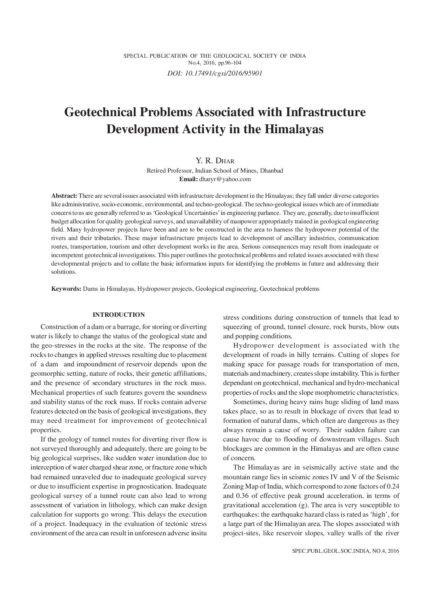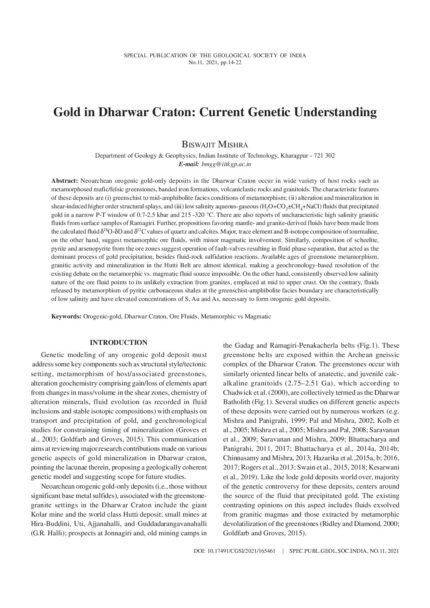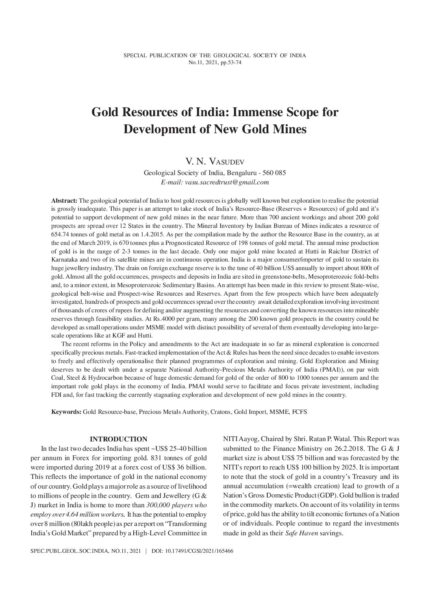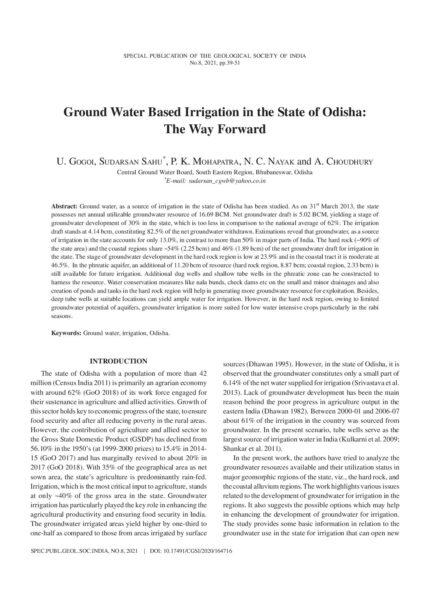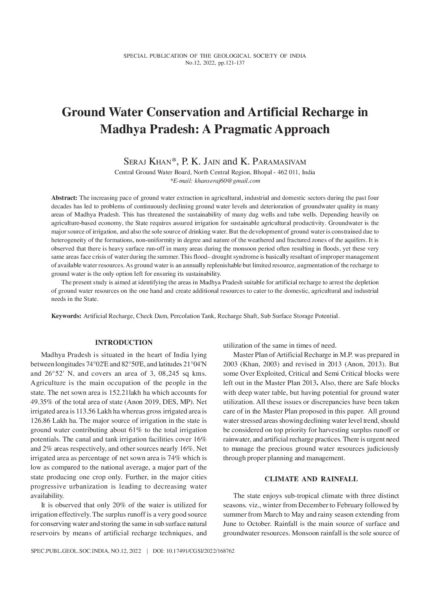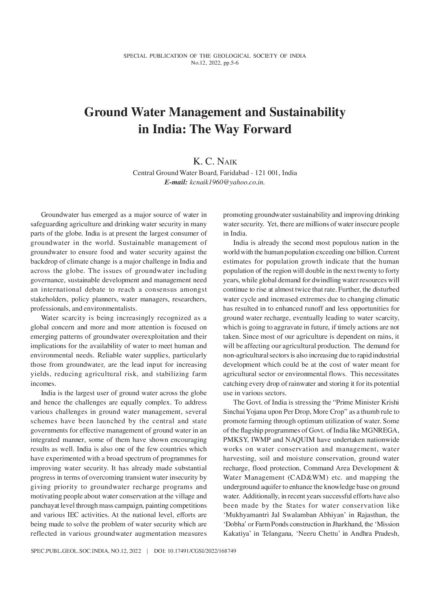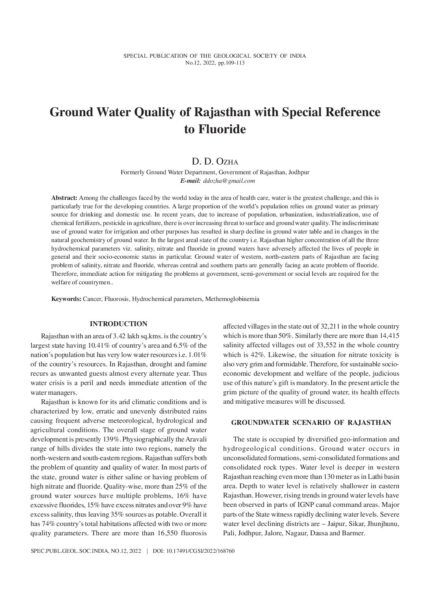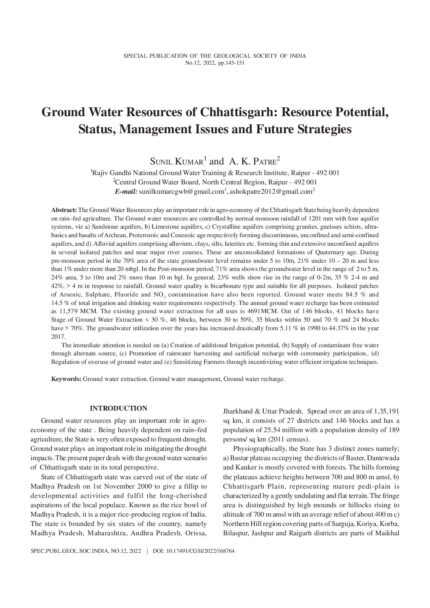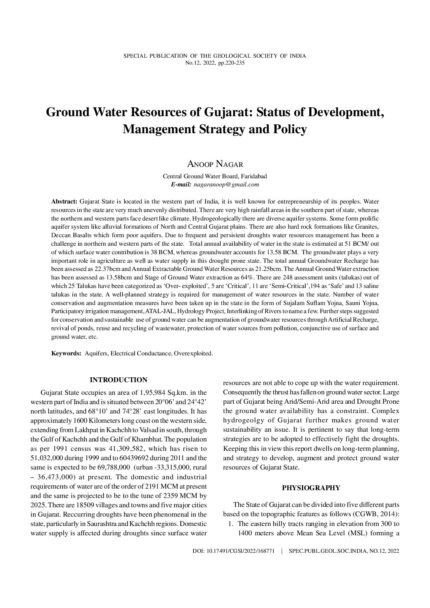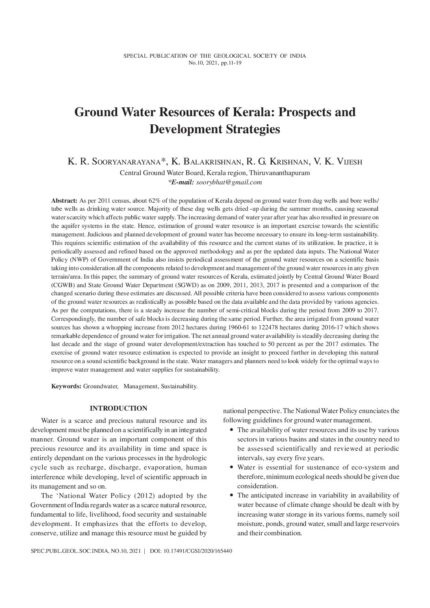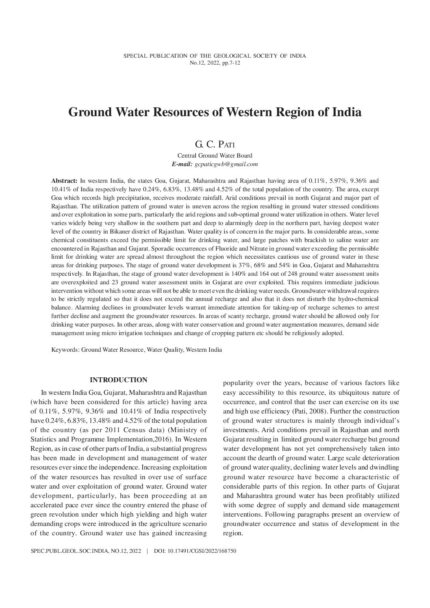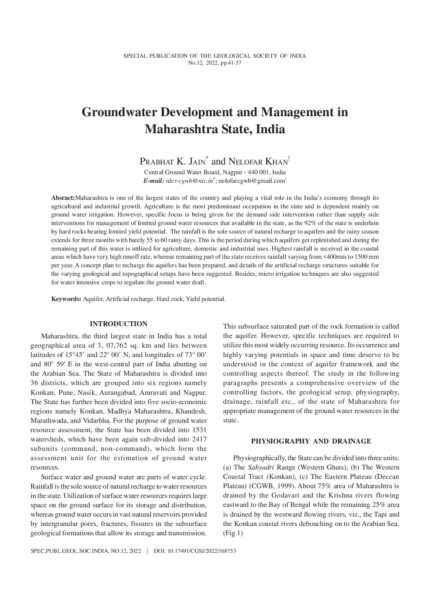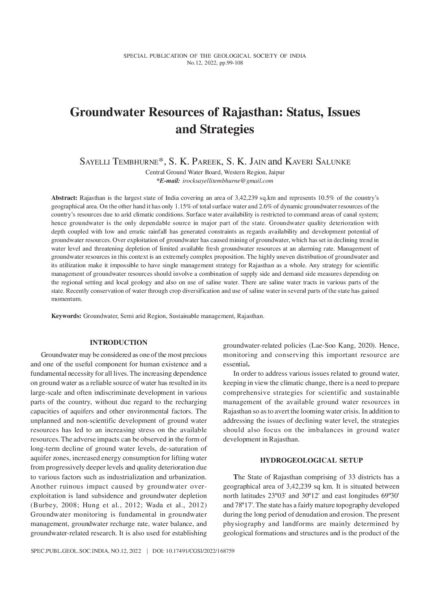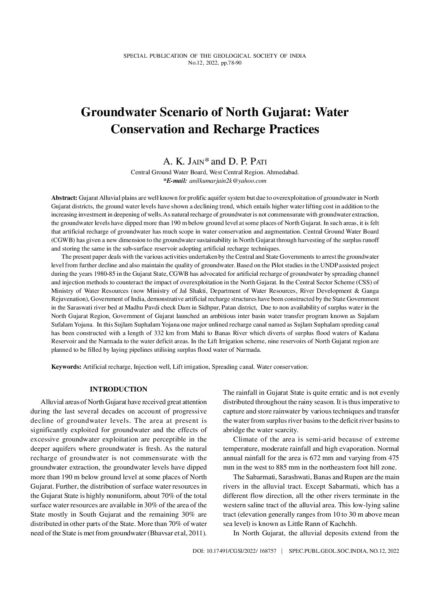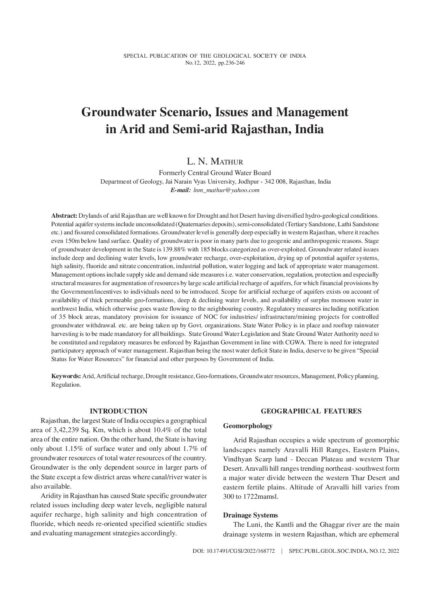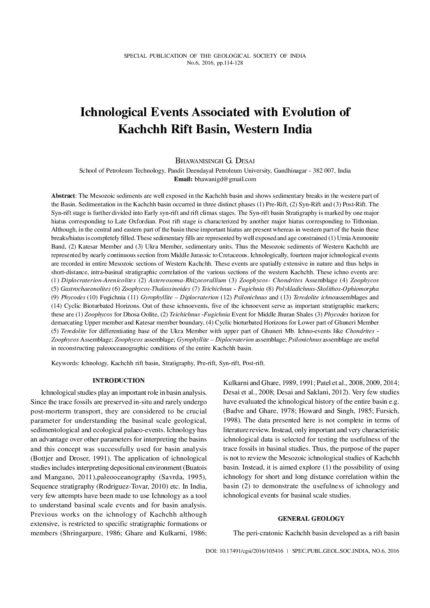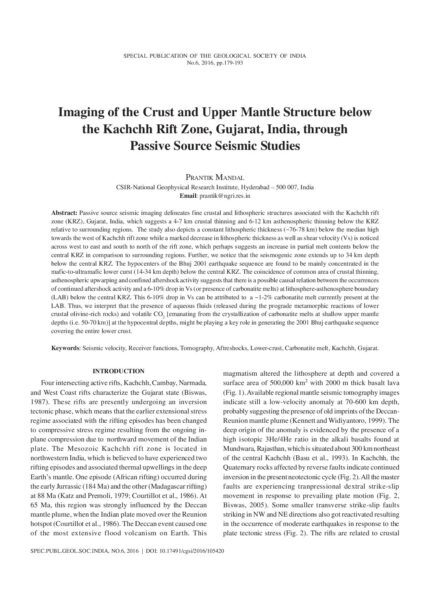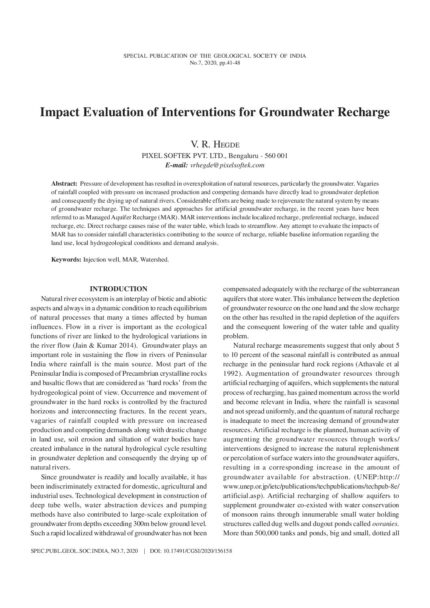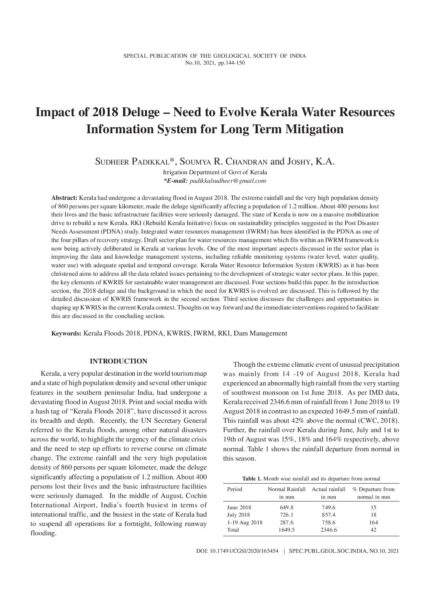Conference Papers
Geotechnical Problems Associated with Infrastructure Development Activity in the Himalayas
SKU:
C-95901
There are several issues associated with infrastructure development in the Himalayas; they fall under diverse categories like administrative, socio-economic, environmental, and techno-geological. The techno-geological issues which are of immediate concern to us are generally referred to as 'Geological Uncertainties' in engineering parlance. They are, generally, due to insufficient budget allocation for quality geological surveys, and unavailability of manpower appropriately trained in geological engineering field. Many hydropower projects have been and are to be constructed in the area to harness the hydropower potential of the rivers and their tributaries. These major infrastructure projects lead to development of ancillary industries, communication routes, transportation, tourism and other development works in the area. Serious consequences may result from inadequate or incompetent geotechnical investigations. This paper outlines the geotechnical problems and related issues associated with these developmental projects and to collate the basic information inputs for identifying the problems in future and addressing their solutions.
Glimpses of Surface Water Scenario in Some Eastern and North Eastern States in India
SKU:
C-165846
The Ganga and the Brahmaputra river system constitute the major river network draining a vast alluvial terrain in eastern and north-eastern sector of India. The Ganga?Brahmaputra?Meghna river system is carrying 1375 BCM water annually. However, distribution of water in these rivers are uneven, bulk of which are available only during four monsoon months of a year. In the remaining eight months the water flow is reduced to its one?sixth amount. A number of Major and Medium Command Area Projects have been implemented. But there are possibilities to harness many more for optimum utilization of available water resources in this part of the country. A number of critical issues like Command Area Management, Resettlement and Rehabilitation of displaced Communities, Flood Management, Drought Management specially in Chotonagpur Plateau areas, Desilting of existing canals, Quality deterioration of river waters await solution.In order to have optimal and rational utilization of available water resources in this part of the country, a number of recommendations have been made.
Gold in Dharwar Craton: Current Genetic Understanding
SKU:
C-165461
Neoarchean orogenic gold-only deposits in the Dharwar Craton occur in wide variety of host rocks such as metamorphosed mafic/felsic greenstones, banded iron formations, volcaniclastic rocks and granitoids. The characteristic features of these deposits are (i) greenschist to mid-amphibolite facies conditions of metamorphism; (ii) alteration and mineralization in shear-induced higher order structural splays, and (iii) low salinity aqueous-gaseous (H2O+CO2?CH4+NaCl) fluids that precipitated gold in a narrow P-T window of 0.7-2.5 kbar and 215-320 ?C. There are also reports of uncharacteristic high salinity granitic fluids from surface samples of Ramagiri. Further, propositions favoring mantle- and granite-derived fluids have been made from the calculated fluid ?18O-?D and ?13C values of quartz and calcites. Major, trace element and B-isotope composition of tourmaline, on the other hand, suggest metamorphic ore fluids, with minor magmatic involvement. Similarly, composition of scheelite, pyrite and arsenopyrite from the ore zones suggest operation of fault-valves resulting in fluid phase separation, that acted as the dominant process of gold precipitation, besides fluid-rock sulfidation reactions. Available ages of greenstone metamorphism, granitic activity and mineralization in the Hutti Belt are almost identical, making a geochronology-based resolution of the existing debate on the metamorphic vs. magmatic fluid source impossible. On the other hand, consistently observed low salinity nature of the ore fluid points to its unlikely extraction from granites, emplaced at mid to upper crust. On the contrary, fluids released by metamorphism of pyritic carbonaceous shales at the greenschist-amphibolite facies boundary are characteristically of low salinity and have elevated concentrations of S, Au and As, necessary to form orogenic gold deposits.
Gold Resources of India: Immense Scope for Development of New Gold Mines
SKU:
C-165466
The geological potential of India to host gold resources is globally well known but exploration to realise the potential is grossly inadequate. This paper is an attempt to take stock of India?s Resource-Base (Reserves + Resources) of gold and it?s potential to support development of new gold mines in the near future. More than 700 ancient workings and about 200 gold prospects are spread over 12 States in the country. The Mineral Inventory by Indian Bureau of Mines indicates a resource of 654.74 tonnes of gold metal as on 1.4.2015. As per the compilation made by the author the Resource Base in the country, as at the end of March 2019, is 670 tonnes plus a Prognosticated Resource of 198 tonnes of gold metal. The annual mine production of gold is in the range of 2-3 tonnes in the last decade. Only one major gold mine located at Hutti in Raichur District of Karnataka and two of its satellite mines are in continuous operation. India is a major consumer/importer of gold to sustain its huge jewellery industry. The drain on foreign exchange reserve is to the tune of 40 billion US$ annually to import about 800t of gold. Almost all the gold occurrences, prospects and deposits in India are sited in greenstone-belts, Mesoproterozoic fold-belts and, to a minor extent, in Mesoproterozoic Sedimentary Basins. An attempt has been made in this review to present State-wise, geological belt-wise and Prospect-wise Resources and Reserves. Apart from the few prospects which have been adequately investigated, hundreds of prospects and gold occurrences spread over the country await detailed exploration involving investment of thousands of crores of rupees for defining and/or augmenting the resources and converting the known resources into mineable reserves through feasibility studies. At Rs.4000 per gram, many among the 200 known gold prospects in the country could be developed as small operations under MSME model with distinct possibility of several of them eventually developing into largescale operations like at KGF and Hutti.The recent reforms in the Policy and amendments to the Act are inadequate in so far as mineral exploration is concerned specifically precious metals. Fast-tracked implementation of the Act & Rules has been the need since decades to enable investors to freely and effectively operationalise their planned programmes of exploration and mining. Gold Exploration and Mining deserves to be dealt with under a separate National Authority-Precious Metals Authority of India (PMAI)), on par with Coal, Steel & Hydrocarbon because of huge domestic demand for gold of the order of 800 to 1000 tonnes per annum and the important role gold plays in the economy of India. PMAI would serve to facilitate and focus private investment, including FDI and, for fast tracking the currently stagnating exploration and development of new gold mines in the country.
Ground Water Based Irrigation in the State of Odisha: The Way Forward
SKU:
C-164716
Ground water, as a source of irrigation in the state of Odisha has been studied. As on 31sta March 2013, the state possesses net annual utilizable groundwater resource of 16.69 BCM. Net groundwater draft is 5.02 BCM, yielding a stage of groundwater development of 30% in the state, which is too less in comparison to the national average of 62%. The irrigation draft stands at 4.14 bcm, constituting 82.5% of the net groundwater withdrawn. Estimations reveal that groundwater, as a source of irrigation in the state accounts for only 13.0%, in contrast to more than 50% in major parts of India. The hard rock (?90% of the state area) and the coastal regions share ?54% (2.25 bcm) and 46% (1.89 bcm) of the net groundwater draft for irrigation in the state. The stage of groundwater development in the hard rock region is low at 23.9% and in the coastal tract it is moderate at 46.5%. In the phreatic aquifer, an additional of 11.20 bcm of resource (hard rock region, 8.87 bcm; coastal region, 2.33 bcm) is still available for future irrigation. Additional dug wells and shallow tube wells in the phreatic zone can be constructed to harness the resource. Water conservation measures like nala bunds, check dams etc on the small and minor drainages and also creation of ponds and tanks in the hard rock region will help in generating more groundwater resource for exploitation. Besides, deep tube wells at suitable locations can yield ample water for irrigation. However, in the hard rock region, owing to limited groundwater potential of aquifers, groundwater irrigation is more suited for low water intensive crops particularly in the rabi seasons.
Ground Water Conservation and Artificial Recharge in Madhya Pradesh: A Pragmatic Approach
Conference Papers, SP-12: Water Resources of Western and Central Regions of India: Status, Issues and Strategies
SKU:
C-168762
The increasing pace of ground water extraction in agricultural, industrial and domestic sectors during the past four decades has led to problems of continuously declining ground water levels and deterioration of groundwater quality in many areas of Madhya Pradesh. This has threatened the sustainability of many dug wells and tube wells. Depending heavily on agriculture-based economy, the State requires assured irrigation for sustainable agricultural productivity. Groundwater is the major source of irrigation, and also the sole source of drinking water. But the development of ground water is constrained due to heterogeneity of the formations, non-uniformity in degree and nature of the weathered and fractured zones of the aquifers. It is observed that there is heavy surface run-off in many areas during the monsoon period often resulting in floods, yet these very same areas face crisis of water during the summer. This flood? drought syndrome is basically resultant of improper management of available water resources. As ground water is an annually replenishable but limited resource, augmentation of the recharge to ground water is the only option left for ensuring its sustainability.The present study is aimed at identifying the areas in Madhya Pradesh suitable for artificial recharge to arrest the depletion of ground water resources on the one hand and create additional resources to cater to the domestic, agricultural and industrial needs in the State.
Ground Water Management, Sustainability and Equity
SKU:
C-95942
Due to the ever-increasing demand for potable and irrigation water, the stress on groundwater is increasing day by day, one of the major factors being rising demand in the irrigation sector of India. This has created severe stress on the available water resource necessitating judicious distribution of the resource and greater water use efficiency. The overall stage of ground water development of our country has already touched 62% as per 2011 estimations. Out of 6607 assessment units (Blocks/ Mandals/talukas/Firkas), 1071 units in various states are overexploited. This statistics points to the urgent need for water management to render it sustainable (Robert W. Kates et al., 2003). It calls for scientific information and management principles considering the social, environmental, legal and economic concerns. The management of ground water as an integral part of the hydrological cycle needs wise beneficial and efficient use including fair allocation, equitable access and monitoring from human, environmental and ecological needs.
Ground Water Quality of Rajasthan with Special Reference to Fluoride
Conference Papers, SP-12: Water Resources of Western and Central Regions of India: Status, Issues and Strategies
SKU:
C-168760
Among the challenges faced by the world today in the area of health care, water is the greatest challenge, and this is particularly true for the developing countries. A large proportion of the world?s population relies on ground water as primary source for drinking and domestic use. In recent years, due to increase of population, urbanization, industrialization, use of chemical fertilizers, pesticide in agriculture, there is over increasing threat to surface and ground water quality. The indiscriminate use of ground water for irrigation and other purposes has resulted in sharp decline in ground water table and in changes in the natural geochemistry of ground water. In the largest areal state of the country i.e. Rajasthan higher concentration of all the three hydrochemical parameters viz. salinity, nitrate and fluoride in ground waters have adversely affected the lives of people in general and their socio-economic status in particular. Ground water of western, north-eastern parts of Rajasthan are facing problem of salinity, nitrate and fluoride, whereas central and southern parts are generally facing an acute problem of fluoride. Therefore, immediate action for mitigating the problems at government, semi-government or social levels are required for the welfare of countrymen.
Ground Water Resources and Development Prospect in the State of Arunachal Pradesh, India
SKU:
C-165842
The state of Arunachal Pradesh covering an area of 83,743 sq. km receives an average rainfall of 3000 mm. It is blessed with favorable natural geo-climatic conditions and resources with rich biodiversity, lush green forest. The state has immense potential to harness hydropower as a major chunk of Brahmaputra basin lies within its territory. In spite of abundant surface water resource in the state, there is acute shortage of water during summer as major part of the rainfall is lost as surface run-off. The Annual extractable Groundwater recharge is 2.667 BCM which should be judiciously utilized in different fields for all round socio-economic upliftment. Hence, a scientific and sustainable approach is required to manage the water resource in the coming years for the overall development of the State and its people.
Ground Water Resources of Chhattisgarh: Resource Potential, Status, Management Issues and Future Strategies
Conference Papers, SP-12: Water Resources of Western and Central Regions of India: Status, Issues and Strategies
SKU:
C-168764
The Ground Water Resources play an important role in agro-economy of the Chhattisgarh State being heavily dependent on rain?fed agriculture. The Ground water resources are controlled by normal monsoon rainfall of 1201 mm with four aquifer systems, viz a) Sandstone aquifers, b) Limestone aquifers, c) Crystalline aquifers comprising granites, gneisses schists, ultrabasics and basalts of Archean, Proterozoic and Cenozoic age respectively forming discontinuous, unconfined and semi-confined aquifers, and d). Alluvial aquifers comprising alluvium, clays, silts, laterites etc. forming thin and extensive unconfined aquifers in several isolated patches and near major river courses. These are unconsolidated formations of Quaternary age. During pre-monsoon period in the 70% area of the state groundwater level remains under 5 to 10m, 21% under 10 ? 20 m and less than 1% under more than 20 mbgl. In the Post-monsoon period, 71% area shows the groundwater level in the range of 2 to 5 m, 24% area, 5 to 10m and 2% more than 10 m bgl. In general, 23% wells show rise in the range of 0-2m, 35 % 2-4 m and 42%, > 4 m in response to rainfall. Ground water quality is bicarbonate type and suitable for all purposes. Isolated patches of Arsenic, Sulphate, Fluoride and NO3 contamination have also been reported. Ground water meets 84.5 % and 14.5 % of total irrigation and drinking water requirements respectively. The annual ground water recharge has been estimated as 11,579 MCM. The existing ground water extraction for all uses is 4691MCM. Out of 146 blocks, 41 blocks have Stage of Ground Water Extraction < 30 %, 46 blocks, between 30 to 50%, 35 blocks within 50 and 70 % and 24 blocks have > 70%. The groundwater utilization over the years has increased drastically from 5.11 % in 1990 to 44.37% in the year 2017.The immediate attention is needed on (a) Creation of additional Irrigation potential, (b) Supply of contaminant free water through alternate source, (c) Promotion of rainwater harvesting and sartificial recharge with community participation,. (d) Regulation of overuse of ground water and (e) Sensitizing Farmers through incentivizing water efficient irrigation techniques.
Ground Water Resources of Eastern and North Eastern States of India
SKU:
C-165838
The states in the Eastern and North Eastern region together having an area of 20.7% of India sustain 26.11% of the population of the country. The annual rain fall of the region is well above the average for India.The Region has some of the most prolific alluvial aquifers. Mostly, water level remains at shallow depths throughout the year barring the hilly areas. Water quality in most parts is suitable for all uses, except certain areas where some constituents exceed the permissible limit for drinking water, and some patches with brackish to saline water. Ground water development has not been at the desired level in the region in sharp contrast to other parts of the country and there is sufficient scope for future development. In the region, highest stage of ground water development is 45% in Bihar and West Bengal followed by 30% in Odisha, 23% in Jharkhand and 16% in Assam. The stage of development in other states is negligible. Judicious and optimal use of the huge reserve of available groundwater resource can bring about sizable improvements in the economy of the region, which is basically agrarian.
Ground Water Resources of Gujarat: Status of Development, Management Strategy and Policy
Conference Papers, SP-12: Water Resources of Western and Central Regions of India: Status, Issues and Strategies
SKU:
C-168771
Gujarat State is located in the western part of India, it is well known for entrepreneurship of its peoples. Water resources in the state are very much unevenly distributed. There are very high rainfall areas in the southern part of state, whereas the northern and western parts face desert like climate. Hydrogeologically there are diverse aquifer systems. Some form prolific aquifer system like alluvial formations of North and Central Gujarat plains. There are also hard rock formations like Granites, Deccan Basalts which form poor aquifers. Due to frequent and persistent droughts water resources management has been a challenge in northern and western parts of the state. Total annual availability of water in the state is estimated at 51 BCM/ out of which surface water contribution is 38 BCM, whereas groundwater accounts for 13.58 BCM. The groundwater plays a very important role in agriculture as well as water supply in this drought prone state. The total annual Groundwater Recharge has been assessed as 22.37bcm and Annual Extractable Ground Water Resources as 21.25bcm. The Annual Ground Water extraction has been assessed as 13.58bcm and Stage of Ground Water extraction as 64%. There are 248 assessment units (talukas) out of which 25 Talukas have been categorized as ?Over- exploited?, 5 are ?Critical?, 11 are ?Semi-Critical?,194 as ?Safe? and 13 saline talukas in the state. A well-planned strategy is required for management of water resources in the state. Number of water conservation and augmentation measures have been taken up in the state in the form of Sujalam Suflam Yojna, Sauni Yojna, Participatory irrigation management, ATAL-JAL, Hydrology Project, Interlinking of Rivers to name a few. Further steps suggested for conservation and sustainable use of ground water can be augmentation of groundwater resources through Artificial Recharge, revival of ponds, reuse and recycling of wastewater, protection of water sources from pollution, conjunctive use of surface and ground water, etc
Ground Water Resources of Jharkhand State and its Development Perspective
SKU:
C-165847
Jharkhand State covering an area of 79714 sq. kms have three major hydrogeological formations consisting of Fissured formation, Semi-Consolidated formation and Porous formation. About 90 percent of area is covered by hard rock (fissured) formation. Chotanagpur Granite gneissic complex consisting of Granite, Granite gneisses, Schists, Phyllites are the major rock formations while Vindhyans, Rajmahal basalts, Laterites, Tertiaries and Alluvium are the minor formations. Exploratory drilling in fissured formation and Rajmahal basalt has revealed that majority of the fractures occur within 130 m bgl. Well discharge in these formations varies, - 10-51 m3/hrs in Rajmahal basalt, 1.5-80 m3/hr in Granite gneisses and 3.6-5 m3/hr in Gondwana formations. As per Ground Water Resources Assessment 2017, the total annual ground water (GW) recharge has been assessed as 6.21 bcm and annual extractable GW Resources is 5.69 bcm. The annual GW extraction is 1.58 bcm and the Stage of GW extraction is 28%. Out of 260 blocks in Jharkhand State, 3 blocks have been categorised as Over-Exploited, 2 as Critical, 10 as Semi-Critical and 245 as Safe. There are no saline blocks in the State. The major ground water issues in Jharkhand State are the areas of intensive Coal, Copper and Uranium mining through which huge volume of ground water is being wasted. Low yield potential in hard rock terrain is another ground water issue. Fluoride contamination has also been observed in 60 blocks in 12 districts.
Ground Water Resources of Kerala: Prospects and Development Strategies
SKU:
C-165440
As per 2011 census, about 62% of the population of Kerala depend on ground water from dug wells and bore wells/ tube wells as drinking water source. Majority of these dug wells gets dried -up during the summer months, causing seasonal water scarcity which affects public water supply. The increasing demand of water year after year has also resulted in pressure on the aquifer systems in the state. Hence, estimation of ground water resource is an important exercise towards the scientific management. Judicious and planned development of ground water has become necessary to ensure its long-term sustainability. This requires scientific estimation of the availability of this resource and the current status of its utilization. In practice, it is periodically assessed and refined based on the approved methodology and as per the updated data inputs. The National Water Policy (NWP) of Government of India also insists periodical assessment of the ground water resources on a scientific basis taking into consideration all the components related to development and management of the ground water resources in any given terrain/area. In this paper, the summary of ground water resources of Kerala, estimated jointly by Central Ground Water Board (CGWB) and State Ground Water Department (SGWD) as on 2009, 2011, 2013, 2017 is presented and a comparison of the changed scenario during these estimates are discussed. All possible criteria have been considered to assess various components of the ground water resources as realistically as possible based on the data available and the data provided by various agencies. As per the computations, there is a steady increase the number of semi-critical blocks during the period from 2009 to 2017. Correspondingly, the number of safe blocks is decreasing during the same period. Further, the area irrigated from ground water sources has shown a whopping increase from 2012 hectares during 1960-61 to 122478 hectares during 2016-17 which shows remarkable dependence of ground water for irrigation. The net annual ground water availability is steadily decreasing during the last decade and the stage of ground water development/extraction has touched to 50 percent as per the 2017 estimates. The exercise of ground water resource estimation is expected to provide an insight to proceed further in developing this natural resource on a sound scientific background in the state. Water managers and planners need to look widely for the optimal ways to improve water management and water supplies for sustainability.
Ground Water Resources of North-Eastern States with Special Reference to Sikkim
SKU:
C-165840
Although India?s Northeast is rich in natural resources, but in terms of development the region lags behind the rest of the country. The Region is characterized by great environmental and natural resource diversity. It consists of eight states ? Arunachal Pradesh, Assam, Manipur, Meghalaya, Mizoram, Nagaland, Sikkim, and Tripura - occupying 262,179 sq. km. It is home to more than 200 out of 450 of India?s tribes. Due to the prevailing geomorphological and agro-climatic conditions in the region, groundwater has a key role in meeting the water needs even in the midst of abundance of rainfall and surface water. The catchment area is hilly with high slope with the result that a major part of the rainfall is lost as surface run off. Apart from this, numerous streams, small rivers, nullas and springs also act as carriers of ground water. Hence, for augmenting the ground water resources of the region to promote all round development, the prospects of development of springs, roof top rainwater harvesting, and construction of shallow tube wells across the region have been discussed in this paper in the light of changing social and economic fabric of the region, and the outlook on development challenges.
Ground Water Resources of Western Region of India
Conference Papers, SP-12: Water Resources of Western and Central Regions of India: Status, Issues and Strategies
SKU:
C-168750
In western India, the states Goa, Gujarat, Maharashtra and Rajasthan having area of 0.11%, 5.97%, 9.36% and 10.41% of India respectively have 0.24%, 6.83%, 13.48% and 4.52% of the total population of the country. The area, except Goa which records high precipitation, receives moderate rainfall. Arid conditions prevail in north Gujarat and major part of Rajasthan. The utilization pattern of ground water is uneven across the region resulting in ground water stressed conditions and over exploitation in some parts, particularly the arid regions and sub-optimal ground water utilization in others. Water level varies widely being very shallow in the southern part and deep to alarmingly deep in the northern part, having deepest water level of the country in Bikaner district of Rajasthan. Water quality is of concern in the major parts. In considerable areas, some chemical constituents exceed the permissible limit for drinking water, and large patches with brackish to saline water are encountered in Rajasthan and Gujarat. Sporadic occurrences of Fluoride and Nitrate in ground water exceeding the permissible limit for drinking water are spread almost throughout the region which necessitates cautious use of ground water in these areas for drinking purposes. The stage of ground water development is 37%, 68% and 54% in Goa, Gujarat and Maharashtra respectively. In Rajasthan, the stage of ground water development is 140% and 164 out of 248 ground water assessment units are overexploited and 23 ground water assessment units in Gujarat are over exploited. This requires immediate judicious intervention without which some areas will not be able to meet even the drinking water needs. Groundwater withdrawal requires to be strictly regulated so that it does not exceed the annual recharge and also that it does not disturb the hydro-chemical balance. Alarming declines in groundwater levels warrant immediate attention for taking-up of recharge schemes to arrest further decline and augment the groundwater resources. In areas of scanty recharge, ground water should be allowed only for drinking water purposes. In other areas, along with water conservation and ground water augmentation measures, demand side management using micro irrigation techniques and change of cropping pattern etc should be religiously adopted.
Ground Water Scenario of Meghalaya State: Prospective Areas for Development
SKU:
C-165843
Meghalaya state is basically a hilly terrain with intermontane valleys and tablelands located in Northeastern part of India and lying between latitudes 25?05? and 26?10?N, and longitudes 89?47? and 92?47?E. Major portion of the state is underlain by consolidated formations comprising crystalline, impervious igneous and metamorphic rocks. Ground water in the area is primarily controlled by lithology, structure and physiography. Joints, fractures, fissures of the hard rocks are repository of ground water at depths ranging from 50m to 240m. Dynamic ground water resource of the state as estimated by CGWB (2017) is 1.82 billion cubic meter (BCM) and the annual ground water available is 1.64 billion cubic meter (BCM). The annual ground water extraction is 0.04 billion cubic meter (BCM) and the stage of development is 2.28% against the national average of 63%. All the 11 districts of the state have been categorised as ?safe?. Tribal population is accustomed to use surface water as traditional and conventional source of water supply for domestic purpose. Moreover, they prefer to fetch water from the springs located 2 to 5 km away instead of getting bore well water at door step. Hence participation of tribal community alongwith stakeholders in ground water programmes will create greater awareness. Ground water irrigation is almost absent. The paper deals with the ground water scenario of the state with special reference to prospective areas for sustainable ground water development and management.
Groundwater Development and Management in Maharashtra State, India
Conference Papers, SP-12: Water Resources of Western and Central Regions of India: Status, Issues and Strategies
SKU:
C-168753
Maharashtra is one of the largest states of the country and playing a vital role in the India?s economy through its agricultural and industrial growth. Agriculture is the most predominant occupation in the state and is dependent mainly on ground water irrigation. However, specific focus is being given for the demand side intervention rather than supply side interventions for management of limited ground water resources that available in the state, as the 92% of the state is underlain by hard rocks bearing limited yield potential. The rainfall is the sole source of natural recharge to aquifers and the rainy season extends for three months with barely 55 to 60 rainy days. This is the period during which aquifers get replenished and during the remaining part of this water is utilized for agriculture, domestic and industrial uses. Highest rainfall is received in the coastal areas which have very high runoff rate, whereas remaining part of the state receives rainfall varying from <400mm to 1500 mm per year. A concept plan to recharge the aquifers has been prepared, and details of the artificial recharge structures suitable for the varying geological and topographical setups have been suggested. Besides, micro irrigation techniques are also suggested for water intensive crops to regulate the ground water draft.
Groundwater Potential of Bihar: An Insight into its Sustainable Development and Management
SKU:
C-165848
The state of Bihar, an agrarian state, is bestowed with a vast, fertile alluvial tract and abundant water resources which hold key to its economic development. This annually replenishable natural resource is beset with several management problems. The surface water irrigation projects are unable to provide adequate supply of water to the farmers and have also caused water logging and salinity problems. Further, variations in precipitation in time and space have often led to drought-flood syndrome creating water crisis. Consequently, ubiquitous occurrence, immunity from drought for two or three consecutive water-years and the relative ease of decentralized access have all led to groundwater being the backbone of agriculture and drinking water in the state. Hydrogeological and geophysical surveys have enabled delineation of ground water occurrences, and their development potentials. Hydro-chemical studies have revealed sporadic arsenic contamination in shallow aquifers along the banks of the River Ganga and fluoride contamination in the hard rock areas in parts of South Bihar. This paper presents elaborately an account of shallow as well as deeper aquifers, their potential in the state along with the possibility of sustainable development and management of the aquifers.
Groundwater Quality in North-Eastern States
SKU:
C-165845
In India, majority of the population depend on groundwater to meet their daily requirement. In North Eastern States, though surface water is supplied to the people in hilly areas but in plains groundwater is extensively used for public supply. In the State of Assam where major sources of public water supply are groundwater, people in several districts are facing problem due to contamination of groundwater with excess iron, arsenic and fluoride. Tripura State is also mostly groundwater dependent and in this State 53.11% habitations are facing problem due to presence of iron beyond permissible limit. In addition, presence of arsenic beyond 10 ppb (acceptable limit) could be found in Tripura. In the States of Arunachal Pradesh, Meghalaya and Nagaland where groundwater is supplied, presence of iron beyond permissible limit has been reported. However, in surface water supply systems of North-eastern States arsenic, fluoride and iron contamination have not been reported.
Groundwater Resources of Rajasthan: Status, Issues and Strategies
Conference Papers, SP-12: Water Resources of Western and Central Regions of India: Status, Issues and Strategies
SKU:
C-168759
Rajasthan is the largest state of India covering an area of 3,42,239 sq.km and represents 10.5% of the country?s geographical area. On the other hand it has only 1.15% of total surface water and 2.6% of dynamic groundwater resources of the country?s resources due to arid climatic conditions. Surface water availability is restricted to command areas of canal system; hence groundwater is the only dependable source in major part of the state. Groundwater quality deterioration with depth coupled with low and erratic rainfall has generated constraints as regards availability and development potential of groundwater resources. Over exploitation of groundwater has caused mining of groundwater, which has set in declining trend in water level and threatening depletion of limited available fresh groundwater resources at an alarming rate. Management of groundwater resources in this context is an extremely complex proposition. The highly uneven distribution of groundwater and its utilization make it impossible to have single management strategy for Rajasthan as a whole. Any strategy for scientific management of groundwater resources should involve a combination of supply side and demand side measures depending on the regional setting and local geology and also on use of saline water. There are saline water tracts in various parts of the state. Recently conservation of water through crop diversification and use of saline water in several parts of the state has gained momentum.
Groundwater Resources Potential and its Management Strategies in West Bengal
SKU:
C-165850
About two third of West Bengal is covered by alluvial deposits of Sub-Recent to Recent time while the remainder by a wide variety of hard rocks where water scarcity is prevalent. Hydrogeologically fissured and fractured hard rocks predominate in the Peninsular and extra peninsular areas while Quaternary arenaceous formations underlie the plains. Groundwater development in hard rocks is possible through construction of dug well, dug-cum-bore wells as also bore wells. Springs form major source of water in the hilly and mountainous tract and losing sustainability due to climatic change. In spite of prolific resource potential of the vast alluvial aquifer, great deal of anomalies in ground water potential and qualities are noticed. Shallow alluvial aquifers are under extensive exploitation but high incidence of Arsenic in ground water (above permissible limit of 0.01 mg/l) within 100 metre below ground level (mbgl) has been reported from 104 blocks of 10 districts in West Bengal. Fluoride contamination is also prevalent in parts of hard rock areas as also alluvial Barind tract. In the Coastal areas, fresh water bearing aquifers are occurring at places within 120m underlain by saline aquifers while in major parts it is sandwiched by saline aquifers and delineated within 140-360 mbgl. Several issues related to groundwater and management are discussed in the paper.
Groundwater Scenario of North Gujarat: Water Conservation and Recharge Practices
Conference Papers, SP-12: Water Resources of Western and Central Regions of India: Status, Issues and Strategies
SKU:
C-168757
Gujarat Alluvial plains are well known for prolific aquifer system but due to overexploitation of groundwater in North Gujarat districts, the ground water levels have shown a declining trend, which entails higher water lifting cost in addition to the increasing investment in deepening of wells. As natural recharge of groundwater is not commensurate with groundwater extraction, the groundwater levels have dipped more than 190 m below ground level at some places of North Gujarat. In such areas, it is felt that artificial recharge of groundwater has much scope in water conservation and augmentation. Central Ground Water Board (CGWB) has given a new dimension to the groundwater sustainability in North Gujarat through harvesting of the surplus runoff and storing the same in the sub-surface reservoir adopting artificial recharge techniques.The present paper deals with the various activities undertaken by the Central and State Governments to arrest the groundwater level from further decline and also maintain the quality of groundwater. Based on the Pilot studies in the UNDP assisted project during the years 1980-85 in the Gujarat State, CGWB has advocated for artificial recharge of groundwater by spreading channel and injection methods to counteract the impact of overexploitation in the North Gujarat. In the Central Sector Scheme (CSS) of Ministry of Water Resources (now Ministry of Jal Shakti, Department of Water Resources, River Development & Ganga Rejuvenation), Government of India, demonstrative artificial recharge structures have been constructed by the State Government in the Saraswati river bed at Madhu Pavdi check Dam in Sidhpur, Patan district, Due to non availability of surplus water in the North Gujarat Region, Government of Gujarat launched an ambitious inter basin water transfer program known as Sujalam Sufalam Yojana. In this Sujlam Suphalam Yojana one major unlined recharge canal named as Sujlam Suphalam spreding canal has been constructed with a length of 332 km from Mahi to Banas River which diverts of surplus flood waters of Kadana Reservoir and the Narmada to the water deficit areas. In the Lift Irrigation scheme, nine reservoirs of North Gujarat region are planned to be filled by laying pipelines utilising surplus flood water of Narmada.
Groundwater Scenario, Issues and Management in Arid and Semi-Arid Rajasthan, India
Conference Papers, SP-12: Water Resources of Western and Central Regions of India: Status, Issues and Strategies
SKU:
C-168772
Drylands of arid Rajasthan are well known for Drought and hot Desert having diversified hydro-geological conditions. Potential aquifer systems include unconsolidated (Quaternaries deposits), semi-consolidated (Tertiary Sandstone, Lathi Sandstone etc.) and fissured consolidated formations. Groundwater level is generally deep especially in western Rajasthan, where it reaches even 150m below land surface. Quality of groundwater is poor in many parts due to geogenic and anthropogenic reasons. Stage of groundwater development in the State is 139.88% with 185 blocks categorized as over-exploited. Groundwater related issues include deep and declining water levels, low groundwater recharge, over-exploitation, drying up of potential aquifer systems, high salinity, fluoride and nitrate concentration, industrial pollution, water logging and lack of appropriate water management. Management options include supply side and demand side measures i.e. water conservation, regulation, protection and especially structural measures for augmentation of resources by large scale artificial recharge of aquifers, for which financial provisions by the Government/incentives to individuals need to be introduced. Scope for artificial recharge of aquifers exists on account of availability of thick permeable geo-formations, deep & declining water levels, and availability of surplus monsoon water in northwest India, which otherwise goes waste flowing to the neighbouring country. Regulatory measures including notification of 35 block areas, mandatory provision for issuance of NOC for industries/ infrastructure/mining projects for controlled groundwater withdrawal. etc. are being taken up by Govt. organizations. State Water Policy is in place and rooftop rainwater harvesting is to be made mandatory for all buildings. State Ground Water Legislation and State Ground Water Authority need to be constituted and regulatory measures be enforced by Rajasthan Government in line with CGWA. There is need for integrated participatory approach of water management. Rajasthan being the most water deficit State in India, deserve to be given ?Special Status for Water Resources? for financial and other purposes by Government of India.
Hydrogeology of Assam and its Development Prospects
SKU:
C-165841
Assam is endowed with abundant water resources. The large perennial rivers and other water bodies with the rich aquifers speak about the vastness of its water resource. The ground water is available at low to moderate depth almost in the entire state. Although there is seasonal and regional variations in the availability of water resources, the annual availability of water resource remains almost the same. Agriculture has the largest share of water consumption amongst the various uses followed by domestic and industrial uses. With the shifting of focus from large farmers in Green Revolution areas in northwest India to small and marginal farmers in east India for sustaining the production of rice, states like Assam, where potentials for exploiting the existing technology are yet largely untapped, have received greater attention from the government in recent years. This paper presents the hydrogeological setup, availability of dynamic ground water resource and future scope of its development.
Ichnological Events Associated with Evolution of Kachchh Rift Basin, Western India
SKU:
C-105416
The Mesozoic sediments are well exposed in the Kachchh basin and shows sedimentary breaks in the western part of the Basin. Sedimentation in the Kachchh basin occurred in three distinct phases (1) Pre-Rift, (2) Syn-Rift and (3) Post-Rift. The Syn-rift stage is further divided into Early syn-rift and rift climax stages. The Syn-rift basin Stratigraphy is marked by one major hiatus corresponding to Late Oxfordian. Post rift stage is characterized by another major hiatus corresponding to Tithonian. Although, in the central and eastern part of the basin these important hiatus are present whereas in western part of the basin these breaks/hiatus is completely filled. These sedimentary fills are represented by well exposed and age constrained (1) Umia Ammonite Band, (2) Katesar Member and (3) Ukra Member, sedimentary units. Thus the Mesozoic sediments of Western Kachchh are represented by nearly continuous section from Middle Jurassic to Cretaceous. Ichnologically, fourteen major ichnological events are recorded in entire Mesozoic sections of Western Kachchh. These events are spatially extensive in nature and thus helps in short-distance, intra-basinal stratigraphic correlation of the various sections of the western Kachchh. These ichno events are: (1) Diplocraterion-Arenicolites (2) Astereosoma-Rhizocorallium (3) Zoophycos- Chondrites Assemblage (4) Zoophycos (5) Gastrochaeonolites (6) Zoophycos-Thalassinoides (7) Teichichnus - Fugichnia (8) Polykladichnus-Skolithos-Ophiomorpha (9) Phycodes (10) Fugichnia (11) Gyrophyllite - Diplocraterion (12) Psilonichnus and (13) Teredolite ichnoassemblages and (14) Cyclic Bioturbated Horizons. Out of these ichnoevents, five of the ichnoevent serve as important stratigraphic markers; these are (1) Zoophycos for Dhosa Oolite, (2) Teichichnus -Fugichnia Event for Middle Jhuran Shales (3) Phycodes horizon for demarcating Upper member and Katesar member boundary, (4) Cyclic bioturbated Horizons for Lower part of Ghuneri Member (5) Teredolite for differentiating base of the Ukra Member with upper part of Ghuneri Mb. Ichno-events like Chondrites - Zoophycos Assemblage; Zoophycos assemblage; Gyrophyllite - Diplocraterion assemblage; Psilonichnus assemblage are useful in reconstructing paleooceanographic conditions of the entire Kachchh basin.
Imaging of the Crust and Upper Mantle Structure below the Kachchh Rift Zone, Gujarat, India, through Passive Source Seismic Studies
SKU:
C-105420
Passive source seismic imaging delineates fine crustal and lithospheric structures associated with the Kachchh rift zone (KRZ), Gujarat, India, which suggests a 4-7 km crustal thinning and 6-12 km asthenospheric thinning below the KRZ relative to surrounding regions. The study also depicts a constant lithospheric thickness (~76-78 km) below the median high towards the west of Kachchh rift zone while a marked decrease in lithospheric thickness as well as shear velocity (Vs) is noticed across west to east and south to north of the rift zone, which perhaps suggests an increase in partial melt contents below the central KRZ in comparison to surrounding regions. Further, we notice that the seismogenic zone extends up to 34 km depth below the central KRZ. The hypocenters of the Bhuj 2001 earthquake sequence are found to be mainly concentrated in the mafic-to-ultramafic lower curst (14-34 km depth) below the central KRZ. The coincidence of common area of crustal thinning, asthenospheric upwarping and confined aftershock activity suggests that there is a possible causal relation between the occurrences of continued aftershock activity and a 6-10% drop in Vs (or presence of carbonatite melts) at lithosphere-asthenosphere boundary (LAB) below the central KRZ. This 6-10% drop in Vs can be attributed to a ~1-2% carbonatite melt currently present at the LAB. Thus, we interpret that the presence of aqueous fluids (released during the prograde metamorphic reactions of lower crustal olivine-rich rocks) and volatile CO2 [emanating from the crystallization of carbonatite melts at shallow upper mantle depths (i.e. 50-70 km)] at the hypocentral depths, might be playing a key role in generating the 2001 Bhuj earthquake sequence covering the entire lower crust.
Impact Evaluation of Interventions for Groundwater Recharge
SKU:
C-156158
Pressure of development has resulted in overexploitation of natural resources, particularly the groundwater. Vagaries of rainfall coupled with pressure on increased production and competing demands have directly lead to groundwater depletion and consequently the drying up of natural rivers. Considerable efforts are being made to rejuvenate the natural system by means of groundwater recharge. The techniques and approaches for artificial groundwater recharge, in the recent years have been referred to as Managed Aquifer Recharge (MAR). MAR interventions include localized recharge, preferential recharge, induced recharge, etc. Direct recharge causes raise of the water table, which leads to streamflow. Any attempt to evaluate the impacts of MAR has to consider rainfall characteristics contributing to the source of recharge, reliable baseline information regarding the land use, local hydrogeological conditions and demand analysis.
Impact of 2018 Deluge ? Need to Evolve Kerala Water Resources Information System for Long Term Mitigation
SKU:
C-165454
Kerala had undergone a devastating flood in August 2018. The extreme rainfall and the very high population density of 860 persons per square kilometer, made the deluge significantly affecting a population of 1.2 million. About 400 persons lost their lives and the basic infrastructure facilities were seriously damaged. The state of Kerala is now on a massive mobilization drive to rebuild a new Kerala. RKI (Rebuild Kerala Initiative) focus on sustainability principles suggested in the Post Disaster Needs Assessment (PDNA) study. Integrated water resources management (IWRM) has been identified in the PDNA as one of the four pillars of recovery strategy. Draft sector plan for water resources management which fits within an IWRM framework is now being actively deliberated in Kerala at various levels. One of the most important aspects discussed in the sector plan is improving the data and knowledge management systems, including reliable monitoring systems (water level, water quality, water use) with adequate spatial and temporal coverage. Kerala Water Resource Information System (KWRIS) as it has been christened aims to address all the data related issues pertaining to the development of strategic water sector plans. In this paper, the key elements of KWRIS for sustainable water management are discussed. Four sections build this paper. In the introduction section, the 2018 deluge and the background in which the need for KWRIS is evolved are discussed. This is followed by the detailed discussion of KWRIS framework in the second section. Third section discusses the challenges and opportunities in shaping up KWRIS in the current Kerala context. Thoughts on way forward and the immediate interventions required to facilitate this are discussed in the concluding section.

